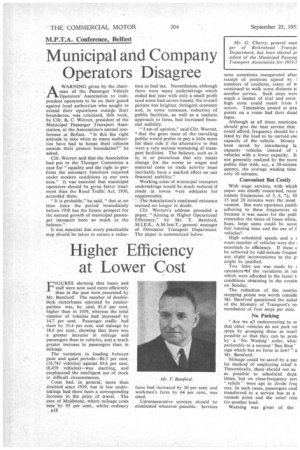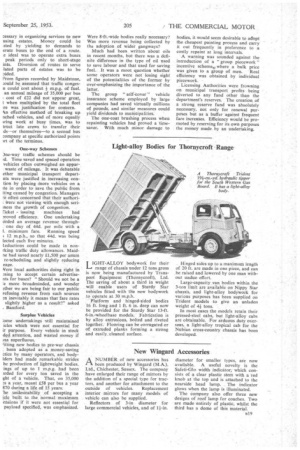Higher Efficiency at Lower Cost
Page 52

Page 53

If you've noticed an error in this article please click here to report it so we can fix it.
FIGURES showing that buses and staff were now used more efficiently than in the past were presented by Mr. Bamford, The number of doubledeck motorbuses operated by municipalities was, he said, 81.6 per cent. higher than in 1939, whereas the total number of -vehicles had increased by 14.7 per cent. Passenger traffic had , risen by 33.4 per cent. and mileage by 18,6 Per cent., showing that there was a greater increase in mileage and passengers than in vehicles, and a much greater increase in passengers than in mileage.
The variation in loading between peak and quiet periods-86,3 per cent. (16,743 vehicles) against 43.6 per cent. (5,459 vehicles)—was startling, and emphasized the intelligent use of stock in difficult circumstances.
Costs had, in genera!, more than doubled since 1939, but in few undertakings had there been a corresponding increase in the price of travel. The case of Maidstone, where mileage costs rose: by 95 per cent, whilst ordinary fares had increased by 30 per cent, and workmen's fares by 64 per cent., was cited.
• Unreinunerative services should be .eliminated •wherever possible. Services were sometimes inaugurated after receipt of petitions signed by I numbers of residents, many of w continued to walk some distance tc another service. Such steps wert much a matter of trial and error high costs could result from 1 action. Timetables posted at stra points on a route had their disad tages.
Although at all times municipa should give the best service that could afford, frequency should be lated by the load to be carried an capacity of the vehicle. Money been saved by introducing Ia capacity vehicles instead of vehicles with a lower capacity. It not generally realized by the trave public that with, say, a 20-minute quency, the average waiting time only 10 minutes.
Convenient But Costly
With stage services, with which paper was chiefly concerned, recur minute frequencies of 5, 6, 7, 10 15 and 20 minutes were the most venient. But were operators justifit adhering to these frequencies sii because it was easier for the publ remember the times of buses when, haps, large sums could be saver fast running time and the use of f vehicles?
High scheduled speeds and a t mum number of vehicles were the essentials to efficiency. If these c be achieved by odd-minute frequer any slight inconvenience to the pi might be justified.
Too little use was made by E operators wof the variations in los which were afforded in the faster ti conditions obtaining in the evenin on Sunday.
The reduction of the numbei stopping points was worth conside Mr. Bamford questioned the suital of the Ministry of Transport's re, mendation of four stops per mile.
No Parking
"Are we all endeavouring to er that other vehicles do not park on stops by grouping these as nearl possible so that they can be prott by a No Waiting' Order, whic: preferable to a normal Bus Stop' sign which has no force in law?" a Mr. Bamford.
Mileage could be saved by a par lar method of employing relief b Theoretically, these should run as as possible to scheduled depa times, but on close-frequency seri, " reliefs " were apt to divide freq cies. In such cases, passengers coul transferred to a service bus at a venient point and the relief retu for another load.
Warning Was given of the :essary in organizing services to new using estates. Money could be .sted by yielding to demands to erate buses to the end of a route. .e ideal was to operate extra buses peak periods only to short-stage ints. Diversion of routes to serve lated parts of estates was to be Dided.
From figures recorded by Maidstone, :ould be assumed that traffic congesn could cost about M.p.g. of fuel. an annual mileage of 35,000 per bus cost of £22 did not appear great, t when multiplied by the total fleet re was justification for concern. kri effective method of breaking up nched vehicles, and of more equally ring work at busy times, was to truct late crews to transfer their ds—or themselves—to a second bus ompany at specific authorized points rt of the terminus.
One-way Schemes )ne-way traffic schemes should be ;d, Time saved and spaced operation vehicles often outweighed an apparwaste of mileage. It was debatable ether municipal transport departnts were justified in increasing conLion by placing More vehicles on a tte in order to save the public from iting caused by congestion. Managers -e often concerned that their authori. Were not viewing with enough seri;ness the growth of congestion.
ricket issuing machines had roved efficiency. One undertaking orded an average •revenue through one day of 44d. per mile with a I. minimum fare. Running speed 3 12 m.p.h., so that 44d. was being lected each five minutes.
leductions could be made in nonrking traffic duty allowances. Maidse had saved nearly £1,500 per anum re-scheduling and slightly reducing cage.
Vere local authorities doing right in Ising to accept certain advertisents for buses? "Should we not be a c more broadminded, and wonder Aber we are being fair to our public refusing revenue from such sources m inevitably it means that fare rates slightly higher as a result?" asked . Bamford.
Surplus Vehicles :ome undertakings still maintained ides which were not essential for Er purpose. Every vehicle in stock ded attention, and wasted money if ms superfluous.
Uting new bodies to pre-war chassis . been adopted as a money-saving Ctice by many operators, and bodylders had made remarkable strides he production of lightweight bodies. ings of up to 1 m.p.g. had been rded for every ton saved in the ght of a vehicle. That, on 35,000 :s a year, meant £58 per bus a year 870 during a life of 15 years.
he undesirability, of accepting a isle bout to the normal maximum ensions if it were not essential for payload specified, was emphasized.
Were 8-ft.-wide bodies really necessary? Was more revenue being collected by the adoption of wider gangways?
Much had been written about oils in recent months, but there was a definite difference in the type of oil used to save labour and that used for saving fuel, It was a moot question whether some operators were not losing sight of the potentialities of the former by over-emphasizing the importance of the latter.
The group " self-cover " vehicle insurance scheme employed by large companies had saved virtually millions of pounds, and similar measures could yield dividends to municipalities.
The one-coat brushing process when repainting vehicles had proved a timesaver. With much minor damage to bodies, it would seem desirable to adopt the cheapest painting process and carry it out frequently in preference to a costly repaint at long intervals.
A warning was sounded against the introduction of a "group piecework" incentive scheme,„ where a bulk price was given to a group of men. Real efficiency was obtained by individual piecework. • Licensing Authorities were frowning on municipal transport profits being diverted to any fund other than the department's reserves. The creation. of a strong reserve fund was absolutely necessary, not only for renewal purposes but as a buffer against frequent fare increases. Efficiency would be promoted by reserving for its own purposes the money made by an undertaking.




























































































